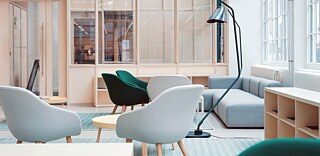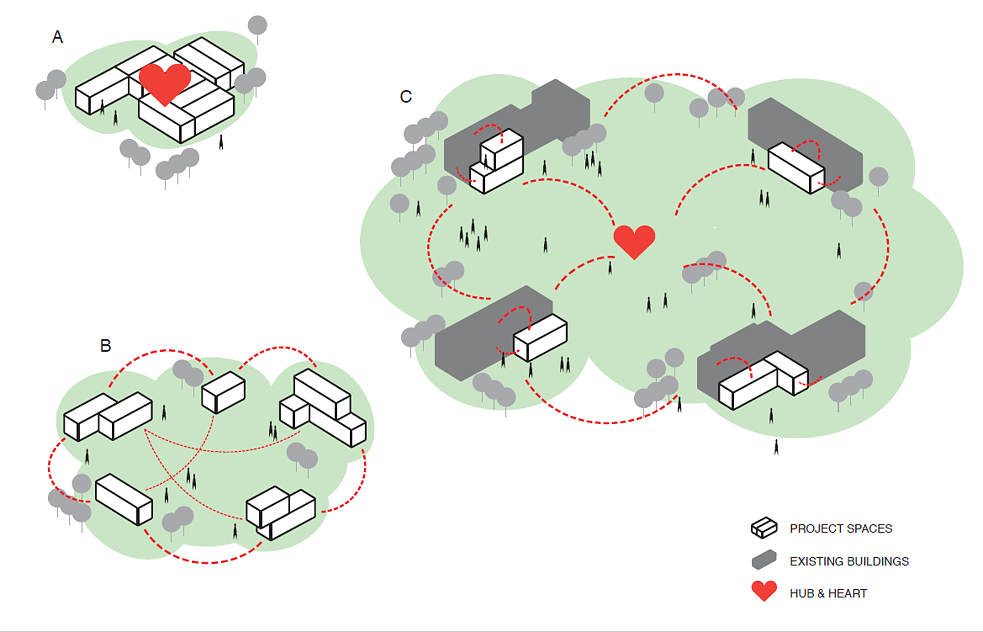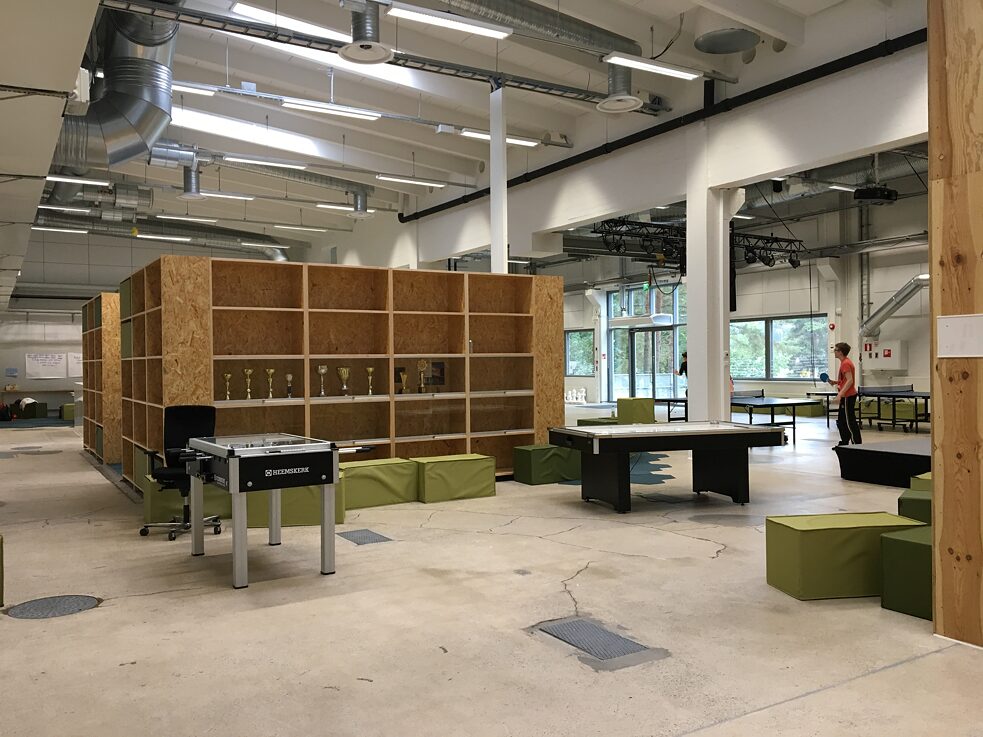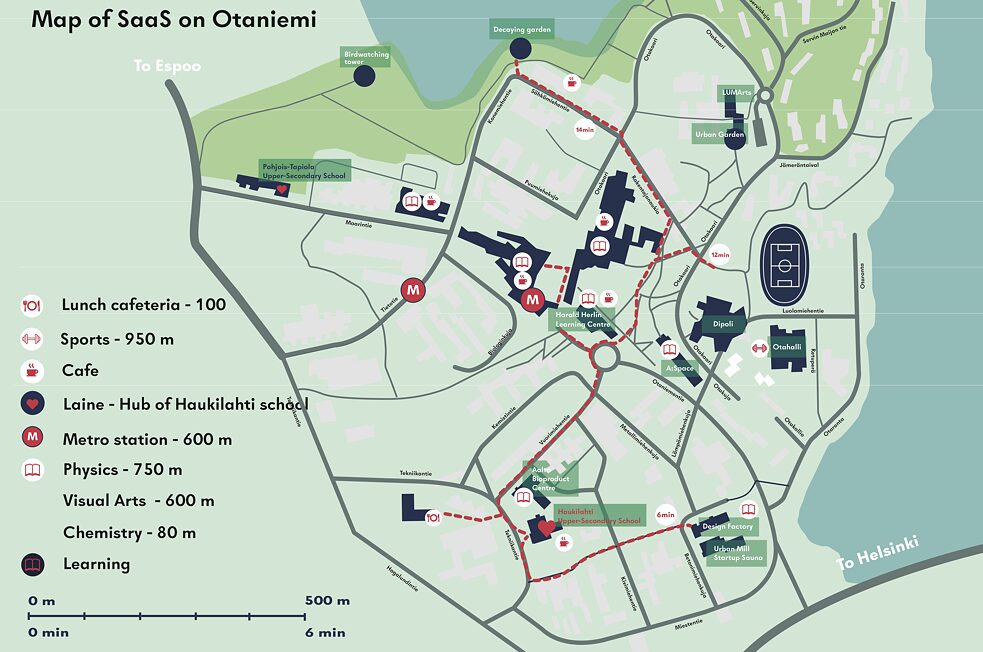
The School as a Service
By Natalia VladykinaThe School as a Service (SaaS) project in Espoo creates a community-driven city.
The humans, their creativity, and experience are core to contemporary city development. The world's distinguished urbanists write about the creative community as the crucial factor to cities' attractiveness and main stimulus for economic growth [1] [2]; culture becomes a crucial extension to technologically smart cities [3]. Aalto University with the local authorities of the City of Espoo started an inspiring School as a Service case urging users to co-create the physical and functional environment of their own school, experiment with school education, and develop a strong cultural identity.
SaaS is built on a service architecture concept, which describes architecture as conditions for services and experiences, making it an instrument to deliver them [4]. The principles of Space as a Service are user-centricity and co-creation, therefore it focuses on platforms that facilitate co-creation [5]. A platform is a form of architecture, in which ownership of one building is replaced with a dynamic network of resources.  Image 1. The School as a Service concept idea. | © Visualisation by Shiyang Shao and Huan Wang, Aalto University.
Image 1. The School as a Service concept idea. | © Visualisation by Shiyang Shao and Huan Wang, Aalto University.
Apart from the conventional closed school building and process, SaaS is conceptualised as an ope engagement platform for learning. Its smart organisation links a network of physical spaces and services, digital tools, and a vibrant social environment together. In SaaS, users focus on their learning and get on-demand access to the suitably equipped spaces: labs, workshops, event spaces, catering, and sports facilities and services from nearby providers.  Image 2. The social space at the school hub. | © Photo by Natalia Vladykina, Aalto University
An important element of the network is the hub featuring a large community space, which is open for users’ initiatives for activities and where a school day starts. Closed digital communications tools serve to control the learning process and maintain the sense of community between school members. Further development of the digital interface of the platform would ease design and management, optimisation of locations and access, improving user experience.
Image 2. The social space at the school hub. | © Photo by Natalia Vladykina, Aalto University
An important element of the network is the hub featuring a large community space, which is open for users’ initiatives for activities and where a school day starts. Closed digital communications tools serve to control the learning process and maintain the sense of community between school members. Further development of the digital interface of the platform would ease design and management, optimisation of locations and access, improving user experience.
 Image 3. The map of SaaS on Otaniemi campus. | © Visualisation by Babi Brasileiro and Juho Heikkinen, Aalto University.
The pilot project of SaaS is located in the Aalto University campus, merging university and school premises and communities together. Many local businesses and city actors also locate their hubs in the university premises. Together they constitute a creative milieu boosting new forms of education, innovations, and business. This context motivates and urges social learning, extracurricular activities, and active social life, which are supported by the school. The learners are not passive users; an opportunity to express creativity in the use of spaces and decide on actions and ways of learning shapes the school’s open culture. As a consequence, the pupils feel confident and prepared for contemporary life.
Image 3. The map of SaaS on Otaniemi campus. | © Visualisation by Babi Brasileiro and Juho Heikkinen, Aalto University.
The pilot project of SaaS is located in the Aalto University campus, merging university and school premises and communities together. Many local businesses and city actors also locate their hubs in the university premises. Together they constitute a creative milieu boosting new forms of education, innovations, and business. This context motivates and urges social learning, extracurricular activities, and active social life, which are supported by the school. The learners are not passive users; an opportunity to express creativity in the use of spaces and decide on actions and ways of learning shapes the school’s open culture. As a consequence, the pupils feel confident and prepared for contemporary life.
The project was developed in an open-ended co-creation process by stakeholders: university, local authorities, school students, teachers, and administration. Participation in the design increases engagement and personal attachment increasing the project's value.
The service architecture approach leads to smarter and more cultured cities. Creativity and innovations hardly occur in organised conditions designed for pre-defined actions [4]. They rather take place spontaneously in open, diverse, cultural contexts that allow creative use [2]. With SaaS blueprint we can reprogram cities as platforms, offering community-driven environments and allowing access to cultural resources, and facilitate interactions between communities, and, therefore, boost smart and creative cities to grow.
References:
[1] Florida, R.L. (2004). The Rise of the Creative Class: And How It’s Transforming Work, Leisure, Community and Everyday Life; Basic Books: New York, NY, USA.
[2] Landry, C. (2006). The Creative City: A Toolkit for Urban Innovators; Reprinted; Comedia: Near Stroud, UK.
[3] von Richthofen, A., Tomarchio, L. and Costa, A. (2019). Identifying Communities Within the Smart-Cultural City of Singapore: A Network Analysis Approach, Smart Cities, 2(1), pp. 66-81.
[4] Suominen, J. (2018). Cities as sustainable service platforms: A framework for institutional service delivery in the urban context. In Cross-Cultural Design. Applications in Cultural Heritage, Creativity and Social Development - 10th International Conference, CCD 2018, Proceedings pp. 371-390.
[5] Ahlava, A., Suominen, J., Rossi, S. (2017). Controlling Risks Through Flexibility and Urban Integration: The Regeneration of Otaniemi Campus in Finland. In Handbook of Theory and Practice of Sustainable Development in Higher Education, Springer International Publishing: Cham, Switzerland, pp. 21–36.
The humans, their creativity, and experience are core to contemporary city development. The world's distinguished urbanists write about the creative community as the crucial factor to cities' attractiveness and main stimulus for economic growth [1] [2]; culture becomes a crucial extension to technologically smart cities [3]. Aalto University with the local authorities of the City of Espoo started an inspiring School as a Service case urging users to co-create the physical and functional environment of their own school, experiment with school education, and develop a strong cultural identity.
SaaS is built on a service architecture concept, which describes architecture as conditions for services and experiences, making it an instrument to deliver them [4]. The principles of Space as a Service are user-centricity and co-creation, therefore it focuses on platforms that facilitate co-creation [5]. A platform is a form of architecture, in which ownership of one building is replaced with a dynamic network of resources.
 Image 1. The School as a Service concept idea. | © Visualisation by Shiyang Shao and Huan Wang, Aalto University.
Image 1. The School as a Service concept idea. | © Visualisation by Shiyang Shao and Huan Wang, Aalto University.
Apart from the conventional closed school building and process, SaaS is conceptualised as an ope engagement platform for learning. Its smart organisation links a network of physical spaces and services, digital tools, and a vibrant social environment together. In SaaS, users focus on their learning and get on-demand access to the suitably equipped spaces: labs, workshops, event spaces, catering, and sports facilities and services from nearby providers.
 Image 2. The social space at the school hub. | © Photo by Natalia Vladykina, Aalto University
Image 2. The social space at the school hub. | © Photo by Natalia Vladykina, Aalto University
 Image 3. The map of SaaS on Otaniemi campus. | © Visualisation by Babi Brasileiro and Juho Heikkinen, Aalto University.
Image 3. The map of SaaS on Otaniemi campus. | © Visualisation by Babi Brasileiro and Juho Heikkinen, Aalto University.
The project was developed in an open-ended co-creation process by stakeholders: university, local authorities, school students, teachers, and administration. Participation in the design increases engagement and personal attachment increasing the project's value.
The service architecture approach leads to smarter and more cultured cities. Creativity and innovations hardly occur in organised conditions designed for pre-defined actions [4]. They rather take place spontaneously in open, diverse, cultural contexts that allow creative use [2]. With SaaS blueprint we can reprogram cities as platforms, offering community-driven environments and allowing access to cultural resources, and facilitate interactions between communities, and, therefore, boost smart and creative cities to grow.
References:
[1] Florida, R.L. (2004). The Rise of the Creative Class: And How It’s Transforming Work, Leisure, Community and Everyday Life; Basic Books: New York, NY, USA.
[2] Landry, C. (2006). The Creative City: A Toolkit for Urban Innovators; Reprinted; Comedia: Near Stroud, UK.
[3] von Richthofen, A., Tomarchio, L. and Costa, A. (2019). Identifying Communities Within the Smart-Cultural City of Singapore: A Network Analysis Approach, Smart Cities, 2(1), pp. 66-81.
[4] Suominen, J. (2018). Cities as sustainable service platforms: A framework for institutional service delivery in the urban context. In Cross-Cultural Design. Applications in Cultural Heritage, Creativity and Social Development - 10th International Conference, CCD 2018, Proceedings pp. 371-390.
[5] Ahlava, A., Suominen, J., Rossi, S. (2017). Controlling Risks Through Flexibility and Urban Integration: The Regeneration of Otaniemi Campus in Finland. In Handbook of Theory and Practice of Sustainable Development in Higher Education, Springer International Publishing: Cham, Switzerland, pp. 21–36.